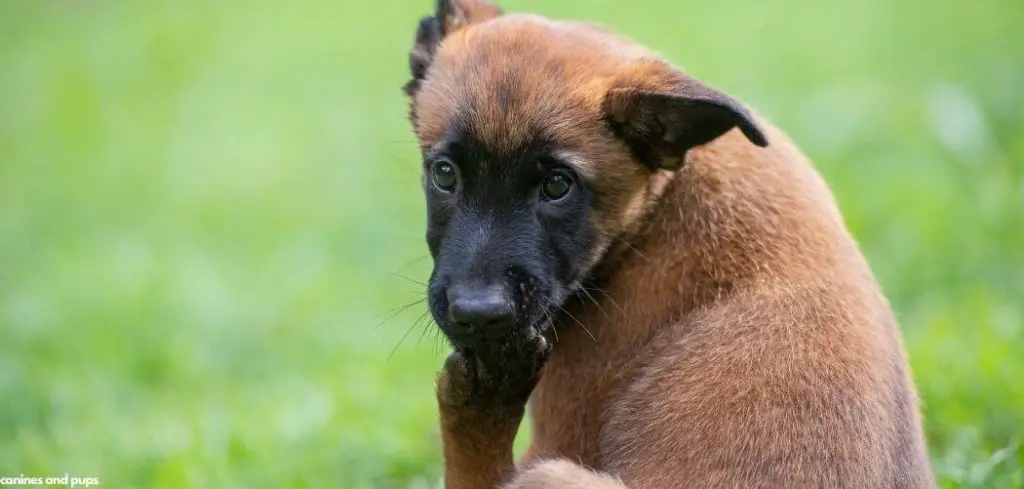Excessive licking of a dog’s back paws can be alarming for owners. While some licking is normal for grooming, repeated or intense licking often indicates irritation or underlying health issues.
Over time, this behavior can damage the skin and cause secondary infections if not addressed.
We outline the common reasons why a dog may excessively lick its back paws, what you can do at home, and when to seek veterinary help.
Dog Excessively Licking Back Paws — Why It Happens
Dogs that excessively lick their back paws are usually responding to discomfort or irritation. This behavior may result from allergies, injuries, infections, parasites, joint problems, or behavioral issues. The licking may occur more frequently at night or after walks when paws come into contact with irritants.
Left unchecked, repetitive licking can lead to raw skin, swelling, and infections that affect mobility and overall well-being.

Dog Excessively Licking Back Paws: Common Causes
Allergies
Environmental or food allergies are a leading cause of paw licking. Pollens, molds, dust, and certain foods can cause intense itching.
Dogs often focus on their back paws because these areas are frequently in contact with allergens on floors, grass, or carpets.
Owners may notice redness, swelling, hair loss, or a yeasty smell. Continuous licking worsens skin damage, increasing infection risk.
Managing allergies often involves dietary adjustments, topical treatments, and, in some cases, veterinary-prescribed medications.
Read more: Dog constantly licking front paws (Here’s what it could mean)
Paw Injuries or Foreign Objects
Cuts, scrapes, bruises, or embedded objects like splinters and thorns can make dogs lick their paws persistently. Licking is their instinctive response to soothe pain and protect the area.
Symptoms may include limping, swelling, or sensitivity when touching the paw. Untreated injuries can lead to worsening inflammation and infection.
Careful inspection and proper cleaning are crucial, and veterinary intervention may be required to remove foreign objects or treat wounds.
Yeast or Bacterial Infections
Back paws can retain moisture between the toes, creating ideal conditions for yeast and bacterial infections. Dogs lick the affected paws to relieve itching, burning, or discomfort.
Signs include a bad odor, greasy or crusty fur, redness, and inflammation. Infections can spread if left untreated, causing more severe discomfort.
A veterinarian may recommend medicated shampoos, antifungal or antibiotic ointments, and oral medications for effective treatment.
Parasites
Fleas, ticks, and mites can irritate the skin on the back paws. Mange-causing mites, in particular, burrow into the skin, causing intense itching that results in excessive licking.
Other signs include hair loss, scabs, and frequent scratching elsewhere on the body. Immediate parasite control is essential to prevent spread, reduce discomfort, and avoid complications from secondary infections.
Anxiety or Compulsive Behavior
Some dogs lick their back paws due to anxiety, stress, or boredom. This compulsive behavior often occurs in response to environmental changes, separation anxiety, or lack of stimulation.
Excessive licking can lead to raw skin, sores, and infections. Behavioral interventions such as increased exercise, mental enrichment, consistent routines, and, in some cases, veterinary-recommended anti-anxiety treatments can help reduce compulsive licking.
Arthritis or Joint Pain
Joint discomfort, especially in older dogs, can lead to paw licking as a coping mechanism.
Arthritis or hip issues may cause pain that radiates down the legs, prompting dogs to lick their paws for relief.
Indicators include stiffness, limping, reluctance to move, and reduced activity levels. Early management with pain relief, joint supplements, and lifestyle modifications can help alleviate discomfort and reduce paw licking behavior.
Read more: Dog Licking Front Paws Excessively at Night (Why it happens)
What to Do If Your Dog Is Excessively Licking Its Back Paws
Start by inspecting your dog’s paws for cuts, swelling, redness, or foreign objects. Gently clean the area with lukewarm water and dry thoroughly. Paw balms or soothing sprays may provide temporary relief for mild irritation.
If allergies are suspected, wipe paws after walks, manage environmental allergens, and discuss hypoallergenic diets with your vet.
For anxiety-related licking, increase exercise, provide interactive toys, and maintain a consistent daily routine. Avoid punishing the dog, and instead redirect their attention when you notice excessive licking.
Persistent or worsening paw licking requires a veterinarian’s evaluation to identify the underlying cause and prevent complications such as infections or chronic skin damage.
When to Call or Visit Your Vet
Seek immediate veterinary care if your dog shows persistent licking that causes raw skin, bleeding, or open wounds.
Watch for signs of infection such as swelling, foul odor, or discharge. Limping, difficulty walking, or lethargy alongside paw licking also warrants prompt attention.
Other red flags include appetite loss, fever, or changes in behavior. Your veterinarian can determine whether allergies, infections, parasites, or joint problems are responsible, and may prescribe appropriate treatments such as medications, dietary changes, or behavior management plans.
Read more: Dog licking paws excessively (When to worry)
Key Takeaway
Excessive licking of back paws is a sign of discomfort or irritation that should not be ignored. Causes can range from allergies and infections to injuries, parasites, joint pain, or behavioral issues.
While some mild cases can be managed at home through cleaning, environmental management, and stress relief, persistent or severe licking requires veterinary evaluation.
Early action helps prevent infections, promote healing, and ensure your dog remains healthy, comfortable, and happy.
